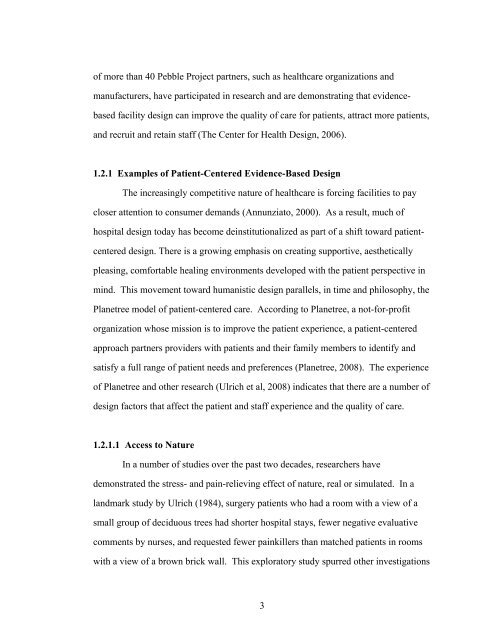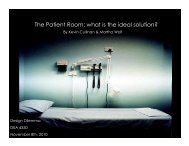The role of physical design and informal communication
The role of physical design and informal communication
The role of physical design and informal communication
Create successful ePaper yourself
Turn your PDF publications into a flip-book with our unique Google optimized e-Paper software.
<strong>of</strong> more than 40 Pebble Project partners, such as healthcare organizations <strong>and</strong><br />
manufacturers, have participated in research <strong>and</strong> are demonstrating that evidence-<br />
based facility <strong>design</strong> can improve the quality <strong>of</strong> care for patients, attract more patients,<br />
<strong>and</strong> recruit <strong>and</strong> retain staff (<strong>The</strong> Center for Health Design, 2006).<br />
1.2.1 Examples <strong>of</strong> Patient-Centered Evidence-Based Design<br />
<strong>The</strong> increasingly competitive nature <strong>of</strong> healthcare is forcing facilities to pay<br />
closer attention to consumer dem<strong>and</strong>s (Annunziato, 2000). As a result, much <strong>of</strong><br />
hospital <strong>design</strong> today has become deinstitutionalized as part <strong>of</strong> a shift toward patient-<br />
centered <strong>design</strong>. <strong>The</strong>re is a growing emphasis on creating supportive, aesthetically<br />
pleasing, comfortable healing environments developed with the patient perspective in<br />
mind. This movement toward humanistic <strong>design</strong> parallels, in time <strong>and</strong> philosophy, the<br />
Planetree model <strong>of</strong> patient-centered care. According to Planetree, a not-for-pr<strong>of</strong>it<br />
organization whose mission is to improve the patient experience, a patient-centered<br />
approach partners providers with patients <strong>and</strong> their family members to identify <strong>and</strong><br />
satisfy a full range <strong>of</strong> patient needs <strong>and</strong> preferences (Planetree, 2008). <strong>The</strong> experience<br />
<strong>of</strong> Planetree <strong>and</strong> other research (Ulrich et al, 2008) indicates that there are a number <strong>of</strong><br />
<strong>design</strong> factors that affect the patient <strong>and</strong> staff experience <strong>and</strong> the quality <strong>of</strong> care.<br />
1.2.1.1 Access to Nature<br />
In a number <strong>of</strong> studies over the past two decades, researchers have<br />
demonstrated the stress- <strong>and</strong> pain-relieving effect <strong>of</strong> nature, real or simulated. In a<br />
l<strong>and</strong>mark study by Ulrich (1984), surgery patients who had a room with a view <strong>of</strong> a<br />
small group <strong>of</strong> deciduous trees had shorter hospital stays, fewer negative evaluative<br />
comments by nurses, <strong>and</strong> requested fewer painkillers than matched patients in rooms<br />
with a view <strong>of</strong> a brown brick wall. This exploratory study spurred other investigations<br />
3







